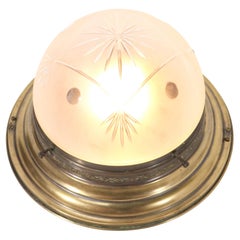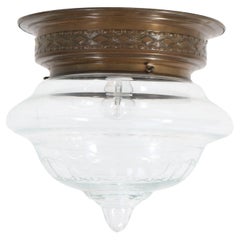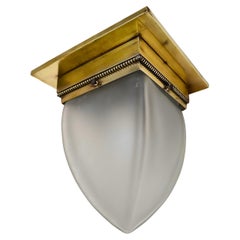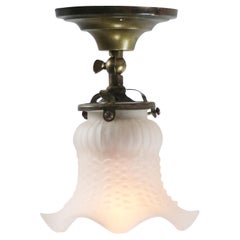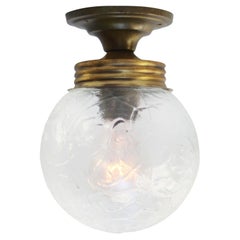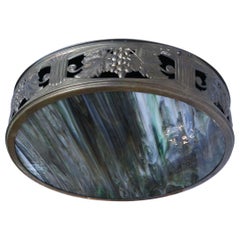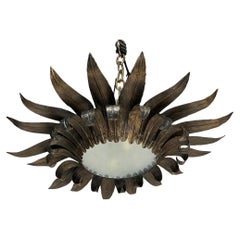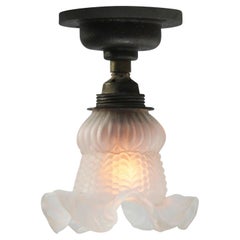Art Nouveau Flush Mount Ceiling Light
Antique Early 1900s French Art Nouveau Flush Mount
Brass
Antique Early 1900s French Art Nouveau Flush Mount
Brass
Early 20th Century German Art Nouveau Flush Mount
Brass
Mid-20th Century French Art Nouveau Flush Mount
Brass
Mid-20th Century French Art Nouveau Flush Mount
Brass
Mid-20th Century British Art Nouveau Flush Mount
Brass
Vintage 1920s French Art Nouveau Flush Mount
Brass
Vintage 1950s Spanish Art Nouveau Flush Mount
Metal
Mid-20th Century French Art Nouveau Flush Mount
Brass, Iron
Early 20th Century German Art Nouveau Flush Mount
Brass
20th Century Italian Hollywood Regency Flush Mount
Brass, Bronze
Mid-20th Century Italian Hollywood Regency Flush Mount
Brass, Bronze
20th Century French Belle Époque Flush Mount
Bronze
Vintage 1910s French Art Nouveau Flush Mount
Bronze
Early 20th Century British Art Nouveau Flush Mount
Crystal, Brass
Early 20th Century British Art Nouveau Flush Mount
Crystal, Brass
Mid-20th Century French Art Nouveau Flush Mount
Brass
Vintage 1950s Spanish Art Nouveau Flush Mount
Metal
Vintage 1950s Spanish Art Nouveau Flush Mount
Metal
Vintage 1950s Spanish Art Nouveau Flush Mount
Metal
Vintage 1950s Spanish Art Nouveau Flush Mount
Metal
Vintage 1950s Spanish Art Nouveau Flush Mount
Metal
Vintage 1950s Spanish Art Nouveau Flush Mount
Metal
Vintage 1960s Spanish Art Nouveau Flush Mount
Metal
Vintage 1950s Spanish Art Nouveau Flush Mount
Metal
Vintage 1950s Spanish Art Nouveau Flush Mount
Metal
Vintage 1950s Spanish Art Nouveau Flush Mount
Metal
Vintage 1950s Spanish Art Nouveau Flush Mount
Metal
Vintage 1960s French Art Nouveau Flush Mount
Metal
Antique Early 1900s French Art Nouveau Chandeliers and Pendants
Brass, Iron
Vintage 1920s French Art Nouveau Chandeliers and Pendants
Metal, Bronze
Early 20th Century American Art Nouveau Chandeliers and Pendants
Bronze
Antique Early 1900s Dutch Art Nouveau Flush Mount
Bronze
Antique Early 1900s French Art Nouveau Flush Mount
Brass
Vintage 1920s French Art Nouveau Flush Mount
Brass
Vintage 1930s American Art Nouveau Flush Mount
Brass
Antique Early 1900s French Art Nouveau Flush Mount
Brass
Antique Early 1900s Dutch Art Nouveau Flush Mount
Brass
Antique Early 1900s French Art Nouveau Flush Mount
Brass
Vintage 1930s Belgian Art Nouveau Flush Mount
Brass, Bronze
Early 20th Century British Art Nouveau Flush Mount
Crystal, Brass
Early 20th Century American Art Nouveau Flush Mount
Early 20th Century British Art Nouveau Flush Mount
Crystal, Brass
Antique Early 1900s French Art Nouveau Flush Mount
Bronze
Early 20th Century American Art Nouveau Flush Mount
Bronze
Early 20th Century American Art Nouveau Flush Mount
Bronze
Vintage 1910s British Art Nouveau Flush Mount
Crystal, Brass, Copper
Vintage 1920s French Art Nouveau Flush Mount
Bronze
Early 20th Century British Art Nouveau Flush Mount
Crystal, Bronze
Vintage 1950s Spanish Art Nouveau Flush Mount
Metal
Vintage 1960s Spanish Art Nouveau Flush Mount
Metal
Vintage 1950s Spanish Art Nouveau Flush Mount
Metal
Vintage 1950s Spanish Art Nouveau Flush Mount
Metal
Vintage 1950s Spanish Art Nouveau Flush Mount
Metal
Vintage 1950s Spanish Art Nouveau Flush Mount
Metal
Vintage 1950s Spanish Art Nouveau Flush Mount
Metal
Vintage 1950s Spanish Art Nouveau Flush Mount
Metal
- 1
Art Nouveau Flush Mount Ceiling Light For Sale on 1stDibs
How Much is a Art Nouveau Flush Mount Ceiling Light?
A Close Look at Art-nouveau Furniture
In its sinuous lines and flamboyant curves inspired by the natural world, antique Art Nouveau furniture reflects a desire for freedom from the stuffy social and artistic strictures of the Victorian era. The Art Nouveau movement developed in the decorative arts in France and Britain in the early 1880s and quickly became a dominant aesthetic style in Western Europe and the United States.
ORIGINS OF ART NOUVEAU FURNITURE DESIGN
- Emerged during the late 19th century
- Popularity of this modernizing style declined in the early 20th century
- Originated in France and Britain but variants materialized elsewhere
- Informed by Rococo, Pre-Raphaelite art, Japanese art (and Japonisme), Arts and Crafts; influenced modernism, Bauhaus
CHARACTERISTICS OF ART NOUVEAU FURNITURE DESIGN
- Sinuous, organic and flowing lines
- Forms that mimic flowers and plant life
- Decorative inlays and ornate carvings of natural-world motifs such as insects and animals
- Use of hardwoods such as oak, mahogany and rosewood
ART NOUVEAU FURNITURE DESIGNERS TO KNOW
ANTIQUE ART NOUVEAU FURNITURE ON 1STDIBS
Art Nouveau — which spanned furniture, architecture, jewelry and graphic design — can be easily identified by its lush, flowing forms suggested by flowers and plants, as well as the lissome tendrils of sea life. Although Art Deco and Art Nouveau were both in the forefront of turn-of-the-20th-century design, they are very different styles — Art Deco is marked by bold, geometric shapes while Art Nouveau incorporates dreamlike, floral motifs. The latter’s signature motif is the "whiplash" curve — a deep, narrow, dynamic parabola that appears as an element in everything from chair arms to cabinetry and mirror frames.
The visual vocabulary of Art Nouveau was particularly influenced by the soft colors and abstract images of nature seen in Japanese art prints, which arrived in large numbers in the West after open trade was forced upon Japan in the 1860s. Impressionist artists were moved by the artistic tradition of Japanese woodblock printmaking, and Japonisme — a term used to describe the appetite for Japanese art and culture in Europe at the time — greatly informed Art Nouveau.
The Art Nouveau style quickly reached a wide audience in Europe via advertising posters, book covers, illustrations and other work by such artists as Aubrey Beardsley, Henri de Toulouse-Lautrec and Alphonse Mucha. While all Art Nouveau designs share common formal elements, different countries and regions produced their own variants.
In Scotland, the architect Charles Rennie Mackintosh developed a singular, restrained look based on scale rather than ornament; a style best known from his narrow chairs with exceedingly tall backs, designed for Glasgow tea rooms. Meanwhile in France, Hector Guimard — whose iconic 1896 entry arches for the Paris Metro are still in use — and Louis Majorelle produced chairs, desks, bed frames and cabinets with sweeping lines and rich veneers.
The Art Nouveau movement was known as Jugendstil ("Youth Style") in Germany, and in Austria the designers of the Vienna Secession group — notably Koloman Moser, Josef Hoffmann and Joseph Maria Olbrich — produced a relatively austere iteration of the Art Nouveau style, which mixed curving and geometric elements.
Art Nouveau revitalized all of the applied arts. Ceramists such as Ernest Chaplet and Edmond Lachenal created new forms covered in novel and rediscovered glazes that produced thick, foam-like finishes. Bold vases, bowls and lighting designs in acid-etched and marquetry cameo glass by Émile Gallé and the Daum Freres appeared in France, while in New York the glass workshop-cum-laboratory of Louis Comfort Tiffany — the core of what eventually became a multimedia decorative-arts manufactory called Tiffany Studios — brought out buoyant pieces in opalescent favrile glass.
Jewelry design was revolutionized, as settings, for the first time, were emphasized as much as, or more than, gemstones. A favorite Art Nouveau jewelry motif was insects (think of Tiffany, in his famed Dragonflies glass lampshade).
Like a mayfly, Art Nouveau was short-lived. The sensuous, languorous style fell out of favor early in the 20th century, deemed perhaps too light and insubstantial for European tastes in the aftermath of World War I. But as the designs on 1stDibs demonstrate, Art Nouveau retains its power to fascinate and seduce.
There are ways to tastefully integrate a touch of Art Nouveau into even the most modern interior — browse an extraordinary collection of original antique Art Nouveau furniture on 1stDibs, which includes decorative objects, seating, tables, garden elements and more.
Finding the Right Flush-mount-ceiling-lights for You
Antique and vintage flush mount lighting fixtures can help you create inviting, ambient lighting in your space, and who doesn’t want that?
While electric light bulbs were a huge improvement over gas and oil lamps for lighting our homes, we still had much work to do in order to arrive at the broad range of table lamps, pendants, sconces and other fixtures that are available today.
Lighting technology and design improved substantially over time. Engaging engineers, scientists, architects and designers alike, the field of lighting became a major proving ground for state-of-the-art materials like plastics, inventive new mechanisms and emotionally resonant styles that included the ethereal (Isamu Noguchi’s Akari light sculpture), the whimsical (Gino Sarfatti’s 2109 ceiling light and Sputnik chandelier) and the eclectically postmodern (the Toio floor lamp crafted by Achille and Pier Giacomo Castiglioni). Eventually, flush mount light fixtures became a practical option for home lighting.
Flush mount lighting fixtures are among the most convenient ways to light a small room with a low ceiling. These structures sit directly against the ceiling’s surface and cast light downward, illuminating a large area and defining the room. Semi-flush mount lighting fixtures hang several inches from the ceiling. They also produce ambient light but can be a little more decorative and lean toward the style of chandeliers.
Flush mount lighting is versatile. Larger fixtures distribute more ambient light across the center of the room, while smaller flush mount fixtures are best for accent or task lighting. The main drawback of flush mount fixtures is that they don’t make a strong statement. You can remedy this by strategically arranging decorative accents that flourish in soft lighting.
Lighting is an essential part of any interior design project. Often, having the right light fixture is key to creating an attractive, radiant room. Ample lighting paired with enticing design creates an elevated, inviting atmosphere, helping to set the desired mood. Selecting the right lighting for your home, however, isn’t merely about creating an especially bright bedroom or a moody dining room. There are many different kinds of fixtures and illumination to consider, with flush mount lighting fixtures among them.
Make a statement with a<a href=/furniture/lighting/flush-mount-ceiling-lights/material/metal/ target="_blank" rel="noopener noreferrer"> metal flush mount lighting fixture — a copper or chrome fixture can prove dazzling in your living room. Art Deco flush mount lighting fixtures, with their geometrical shapes and unique detailing in crystal, glass and brass, will go toward creating a cohesive look amid your collection of authentic Art Deco era posters and other wall decor.
Hollywood Regency fixtures — defined by a flamboyant design style for which we credit decorator Dorothy Draper — can introduce glamour and glitz to your living room with their mirrored finishes and complex floral motifs.
Explore a collection of antique and vintage flush mount lighting fixtures on 1stDibs to see what style best suits your space.
- 1stDibs ExpertAugust 17, 2021As its name implies, a flush mount ceiling light is mounted flush to the ceiling. They’re a good alternative to recessed lighting.
